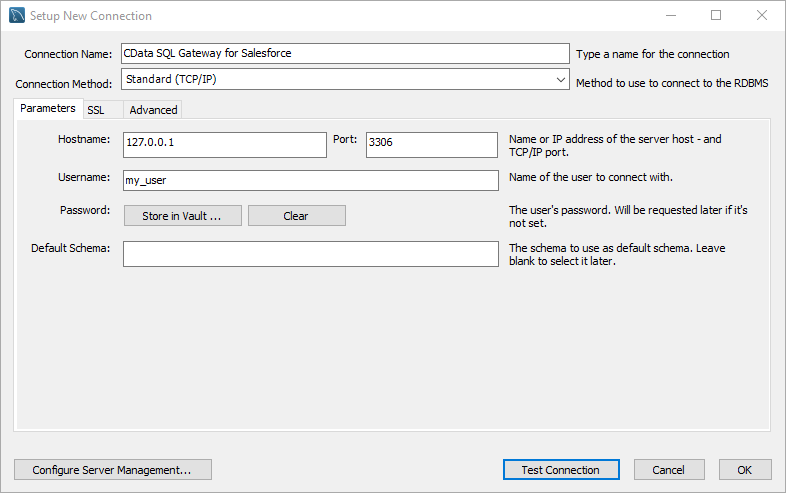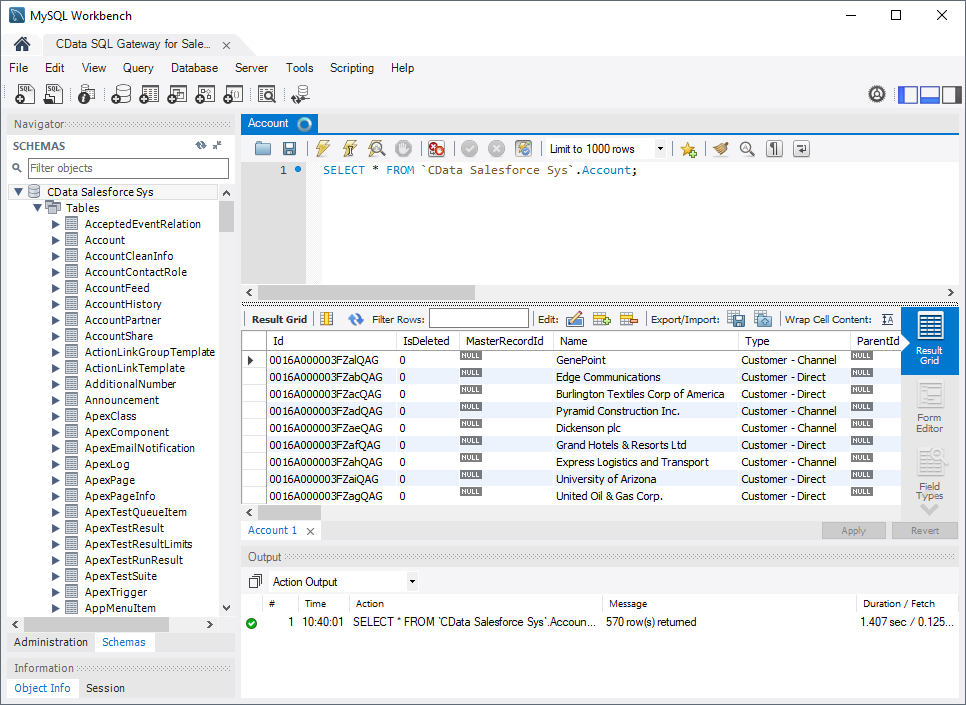Discover how a bimodal integration strategy can address the major data management challenges facing your organization today.
Get the Report →How to Query SingleStore Data in MySQL Workbench
Execute MySQL queries against live SingleStore data from MySQL Workbench.
You can use the SQL Gateway from the ODBC Driver for SingleStore to query SingleStore data through a MySQL interface. Follow the procedure below to start the MySQL remoting service of the SQL Gateway and work with live SingleStore data in MySQL Workbench.
Connect to SingleStore Data
If you have not already done so, provide values for the required connection properties in the data source name (DSN). You can use the built-in Microsoft ODBC Data Source Administrator to configure the DSN. This is also the last step of the driver installation. See the "Getting Started" chapter in the help documentation for a guide to using the Microsoft ODBC Data Source Administrator to create and configure a DSN.
The following connection properties are required in order to connect to data.
- Server: The host name or IP of the server hosting the SingleStore database.
- Port: The port of the server hosting the SingleStore database.
- Database (Optional): The default database to connect to when connecting to the SingleStore Server. If this is not set, tables from all databases will be returned.
Connect Using Standard Authentication
To authenticate using standard authentication, set the following:
- User: The user which will be used to authenticate with the SingleStore server.
- Password: The password which will be used to authenticate with the SingleStore server.
Connect Using Integrated Security
As an alternative to providing the standard username and password, you can set IntegratedSecurity to True to authenticate trusted users to the server via Windows Authentication.
Connect Using SSL Authentication
You can leverage SSL authentication to connect to SingleStore data via a secure session. Configure the following connection properties to connect to data:
- SSLClientCert: Set this to the name of the certificate store for the client certificate. Used in the case of 2-way SSL, where truststore and keystore are kept on both the client and server machines.
- SSLClientCertPassword: If a client certificate store is password-protected, set this value to the store's password.
- SSLClientCertSubject: The subject of the TLS/SSL client certificate. Used to locate the certificate in the store.
- SSLClientCertType: The certificate type of the client store.
- SSLServerCert: The certificate to be accepted from the server.
Connect Using SSH Authentication
Using SSH, you can securely login to a remote machine. To access SingleStore data via SSH, configure the following connection properties:
- SSHClientCert: Set this to the name of the certificate store for the client certificate.
- SSHClientCertPassword: If a client certificate store is password-protected, set this value to the store's password.
- SSHClientCertSubject: The subject of the TLS/SSL client certificate. Used to locate the certificate in the store.
- SSHClientCertType: The certificate type of the client store.
- SSHPassword: The password that you use to authenticate with the SSH server.
- SSHPort: The port used for SSH operations.
- SSHServer: The SSH authentication server you are trying to authenticate against.
- SSHServerFingerPrint: The SSH Server fingerprint used for verification of the host you are connecting to.
- SSHUser: Set this to the username that you use to authenticate with the SSH server.
Configure the SQL Gateway
See the SQL Gateway Overview to set up connectivity to SingleStore data as a virtual MySQL database. You will configure a MySQL remoting service that listens for MySQL requests from clients. The service can be configured in the SQL Gateway UI.

Query SingleStore from MySQL Workbench
The steps below outline connecting to the virtual SingleStore database created in the SQL Gateway from MySQL Workbench and issuing basic queries to work with live SingleStore data.
Connect to SingleStore through the SQL Gateway
- In MySQL Workbench, click to add a new MySQL connection.
- Name the connection (CData SQL Gateway for SingleStore).
- Set the Hostname, Port, and Username parameters to connect to the SQL Gateway.
- Click Store in Vault to set and store the password.
- Click Test Connection to ensure the connection is configured properly and click OK.

Query SingleStore Data
- Open the connection you just created (CData SQL Gateway for SingleStore).
- Click File -> New Query Tab.
- Write a SQL query to retrieve SingleStore data, like SELECT * FROM `CData SingleStore Sys`.Orders;

With access to live SingleStore data from MySQL Workbench, you can easily query and update SingleStore, just like you would a MySQL database. Get started now with a free, 30-day trial of the CData ODBC Driver for SingleStore and the CData SQL Gateway.






